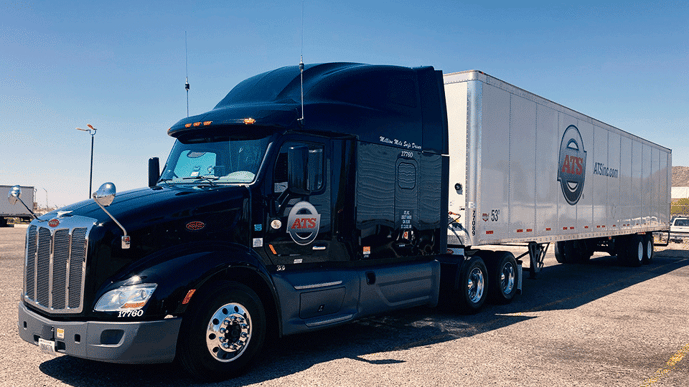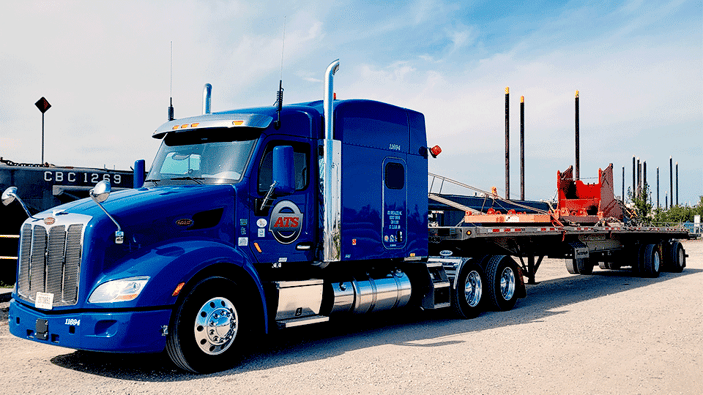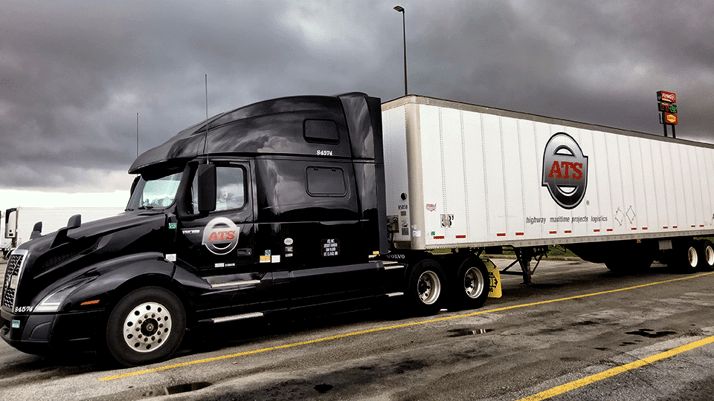It’s natural to feel overwhelmed when selecting a transportation service for your business; there are a ton of great options.
Plenty of shippers, just like you, face this hurdle every day, seeking to take their transportation dollars further while simultaneously maintaining their production and delivery schedules.
However, with few resources outlining the pros and cons of using each service type, this vast array of choices can actually do more harm than good, leaving companies to select without all of the information.
For companies that move smaller quantities of freight — quantities that don’t require the entire capacity of a trailer — there is a list of services to choose from. Deciding between partial truckload and less-than-truckload services can be difficult.
Over the past six decades, Anderson Trucking Service (ATS) has moved extensive quantities of both PTL and LTL shipments, so we intimately understand each of these services. In this article, we’ll pass this information on to you so that you can truly make the best possible decision for your freight.
Below, you’ll find a comprehensive overview of:
- The advantages of partial truckload transportation
- The disadvantages of partial truckload transportation
- The advantages of less-than-truckload transportation
- The disadvantages of less-than-truckload transportation
Without these understandings, some companies lose out on well-deserved cost savings and struggle to meet the commitments they make.
What Are The Advantages of Partial-Truckload Transportation?
Partial truckload shipping is a viable option for shipments weighing up to 30,000 pounds and/or measuring up to 30 feet in length. Where LTL services dole out trailer space between upwards of 5 or more companies, PTL transportation is a bit more exclusive — making it a great option when the shoe fits.
The three biggest advantages of using PTL transportation services over LTL services are:
- PTL shipments undergo less handling
- PTL shipments offer greater in-transit visibility
- PTL shipping is faster than LTL shipping
#1: PTL Shipments Undergo Less Handling
By and large, partial truckload freight is handled far less frequently than less-than-truckload shipments.
Less-than-truckload shipping is typically a terminal-based procedure — each load is transported from one facility to the next and repositioned either to another trailer or to make room for additional cargo.
Each of these “touchpoints,” heightens the potential for damage to LTL cargo before it ever reaches its endpoint.
Partial truckload shipping, a process where freight is handled far less frequently, can help you avoid many of these issues. Since PTL freight isn’t transferred from one trailer to the next, as long as carriers organize their trailer space efficiently, once your product is secured it won’t move until it delivers.
As a result, expect to experience fewer cargo claims due to damaged freight when shipping PTL. Additionally, PTL shipments receive a minimum cargo coverage of $100,000, making this a safer solution for more valuable cargo.

#2: PTL Shipments Offer Greater In-Transit Visibility
Most shipments sent via partial service come equipped with the same tracking capabilities offered by full-truckload transportation.
Where LTL transportation sends shippers “key indicator” updates — recorded each time an event occurs (scanning at a facility, leaving a location, etc.) — PTL trucking allows shippers to track cargo at any time.
This information can then be relayed to customers/receivers to ensure they're prepared for the arrival of the shipment — a convenience LTL services don’t naturally provide.
#3: PTL Shipping is Faster Than Shipping LTL
One of the main drawbacks of less-than-truckload shipping is the lengthy transit times that can accompany it. Unless they use expedited services, shippers often find it difficult to meet tight deadlines when sending freight LTL.
Although PTL shipping still presents an issue where transit timing is concerned — compared to dedicated services — this discrepancy is less drastic.
With PTL, your truck will need to make multiple pickups and deliveries — which can make predicting arrival times difficult — but your load will never have to change trailers once situated and far fewer shippers will share your trailer.

As a general rule of thumb, expect a more expedited delivery timeframe when shipping PTL than LTL services can offer.
What Are The Disadvantages of Partial-Truckload Transportation?
Like both less-than-truckload and full-truckload transportation, partial truckload shipping has some downsides to note. And, in the pursuit of making the best possible solution for your business, it’s crucial that you truly understand what you’ll receive by utilizing PTL services over their LTL alternative.
The three largest disadvantages of using PTL transportation services over LTL services are:
- PTL transportation is typically more expensive than LTL
- Securing PTL capacity can be more challenging
- PTL shipping takes some flexibility on the front end
#1: PTL Transportation is Typically More Expensive Than LTL
Since you’re sending larger quantities of freight, tying up a larger portion of their hours of service and trailer, PTL shipping will be more expensive than LTL.

Typically, the cost of partial-truckload capacity directly correlates to the percentage of overall trailer space a shipper is using. If, for example, your freight is 28 feet long, occupying 52 percent of a 53-foot trailer and the rate of dedicated service (an entire trailer) is $1,000, expect to pay $520 to secure PTL capacity.
The convenience of having a partially-dedicated truck, trailer and driver comes at an elevated cost when compared to smaller-quantity services. Fewer businesses are chipping in to pay for that trucker’s services — which is the only way they make money.
For this reason, PTL shipping is usually more costly than sending cargo LTL which calculates pricing based on a load’s freight class and size.
#2: Securing PTL Capacity Can Be More Challenging
Compared to less-than-truckload solutions, it’s often more difficult to secure partial-truckload capacity. Due to the fact that these loads are time-consuming for drivers and difficult to plan out logistically, many carriers — even those specializing in LTL transportation — steer clear of offering partial service.
As a result, it’s not uncommon for shippers with PTL cargo to struggle to find a solution for these goods — making them difficult to arrange in times of urgency.

#3: PTL Shipping Takes Some Flexibility On The Front End
Because partial-truckload services are relatively scarce, securing PTL solutions can’t be done on short notice. Although the delivery timing consistency and predictability of PTL shipping are better than those associated with LTL transport, on the front end, securing service will require flexibility.
Due to the abundance of less-than-truckload carriers in a given area, arranging a same-day pickup, though more challenging, isn’t impossible. The same can’t be said of partial-truckload shipping. Instead, should you decide this service is right for you, you’ll want to budget a two to three-day window for pickup.
Related Content: What is Partial Truckload (PTL) Freight Shipping [Pros + Cons]
What Are The Advantages of Less-Than-Truckload Transportation?
Now that you have a better understanding of the advantages and disadvantages of using partial truckload services, let’s talk about the other side of this coin: less-than-truckload service.
More specifically, let’s go through the main advantages of using less-than-truckload capacity to move your cargo.
The two biggest advantages of using LTL transportation services over PTL services are:
- There is plenty of less-than-truckload capacity available
- LTL shipping is cheaper than PTL shipping
#1: There is Plenty of Less-Than-Truckload Capacity Available
The transportation industry is huge. That said, not every company has full-truckload volumes of freight to move — a fact that’s not lost on many carriers. As such, there’s typically no shortage of less-than-truckload solutions available to those who need them.
In turn, shippers with LTL freight to move will have no trouble doing so on an ongoing basis in accordance with their schedules.

#2: LTL Shipping Is Cheaper Than PTL Shipping
Since less-than-truckload quantities of cargo typically range between 150 and 15,000 pounds, more of these shipments can be loaded onto each trailer. In turn, with more parties chipping in — subsidizing the price of paying for that driver’s time — moving your goods will be more cost-effective with LTL.
This, of course, will depend on your cargo’s class and overall size. And, as the amount of trailer space your freight occupies increases, expect your rate to do the same. But still, shipping LTL will cost less than PTL.
What Are The Disadvantages of Less-Than-Truckload Transportation?
Less-than-truckload shipping, though a great solution for many businesses, isn’t the right fit for all of them. While its price point and supplier density are large selling points, here are some disadvantages of LTL shipping that you should also note.
The three largest disadvantages of LTL shipping are:
- Unpredictable transit and delivery times
- The potential for cargo damage during handling
- LTL service may not be available along low-volume routes
#1: Unpredictable Transit and Delivery Times
Since LTL carriers need to make so many stops along a given route — picking up and dropping off cargo — it can be really challenging to predict and plan around how long your shipment will take.
While you can request a “notification before delivery” (at an extra charge), the transit speed and delivery timeframe of an LTL can’t be predicted at the time of pickup.
As such, should you decide to send your cargo LTL, it’s crucial that your delivery time isn’t rigid and failing to meet it won’t hurt your relationships.
Related: Why is My Freight Shipment Taking So Long? [LTL, PTL & FTL Comparison]
#2 The Potential For Cargo Damage During Handling
No matter where your freight falls within the pickup schedule of your less-than-truckload carrier, it will likely be handled frequently during its journey.
You see, in order to situate everything properly at each pickup, and maximize their trailer space, sometimes LTL cargo must be removed, handled and repositioned at every pickup/drop.
And, even though proper packaging will go a long way toward protecting your LTL freight, damage may still occur. For this reason, try to avoid using LTL capacities to move high-value or delicate freight.

#3 LTL Service May Not Be Available Along Low-Volume Routes
Filling the entirety of a semi-trailer with LTL quantities of freight takes the consolidation of many shipments. Without a fully-loaded trailer, providing less-than-truckload services is neither time nor cost-effective for carriers.
As a result trucking companies don’t offer LTL services along every route — making it challenging to secure capacity in more remote areas.
This is often less of a challenge for partial-truckload shippers that take up a larger portion of each trailer, requiring fewer companions in the end.
LTL or PTL: Which is Right For You?
Even with the information listed above, choosing your best-fit transportation solution won’t be easy. By and large, however, there are situations where choosing one of these solutions over the other.
For example, whenever your freight exceeds eight feet long, partial truckload service is typically more cost-effective than less-than-truckload. Additionally, less-than-truckload spot rates are typically more competitive when the transportation market is volatile — making it easier to secure capacity in these instances.
To help you make your selection, here is a chart comparing PTL and LTL shipping side by side:
| Partial Truckload (PTL) | Less Than Truckload (LTL) | |
| Price (Generally) | Higher | Lower |
| Capacity Available (Generally) | Average | High |
| Cargo Safety | Average | Below Average |
| Transit Timing Predictability | Below Average | Low |
| Load Tracking Visibility | Average | Low |
| Cargo Insurance Coverage | Average | Below Average |
| Fit For Tight Deadlines | Below Average | Below Average |
| Fit For Palletized Freight | Average | High |
If you have any more questions about either of these services or the ATS transportation service offerings, please don’t hesitate to contact us today.
We have a seasoned transportation expert ready and willing to help you in any way you need.




